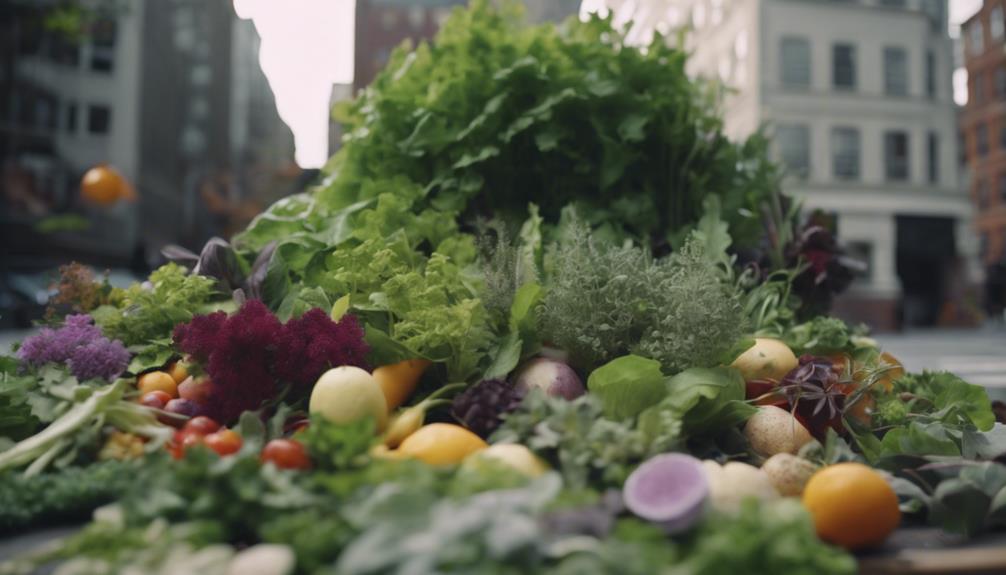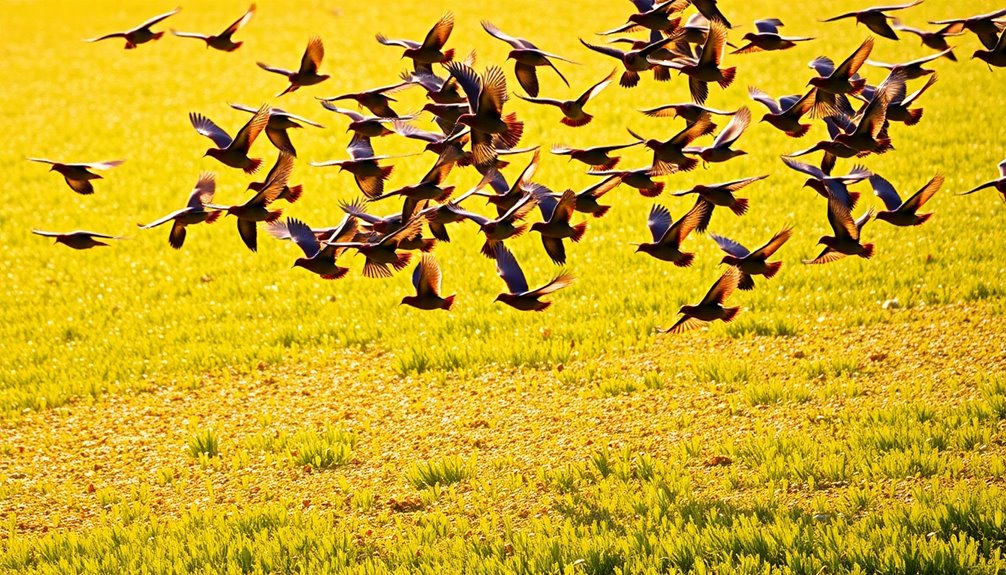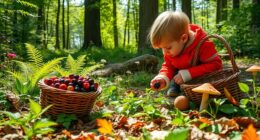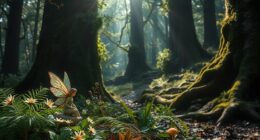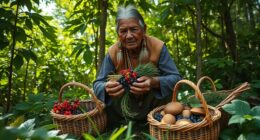Yes, foraging is legal in Texas, but you need to know the guidelines. On public lands, you can collect 1 gallon of mushrooms or 1 pint of fruits, nuts, or berries per person each day. However, always get permission before foraging on private property. Local laws might add restrictions, so staying informed is vital to avoid hefty fines. While foraging connects you with nature, it's also essential to practice ethical and safe foraging habits. The more you explore, the better you'll understand what's available and how to enjoy these wild foods responsibly.
Key Takeaways
- Foraging is legal in Texas, but regulations vary depending on public or private land.
- On public lands, foragers can collect 1 gallon of mushrooms or 1 pint of fruits/nuts/berries daily.
- Foraging on private property requires explicit permission from landowners.
- Local ordinances may impose additional restrictions, so understanding local laws is essential.
- Fines for illegal foraging in Texas can range from $500 to $2100.
Foraging Overview in Texas
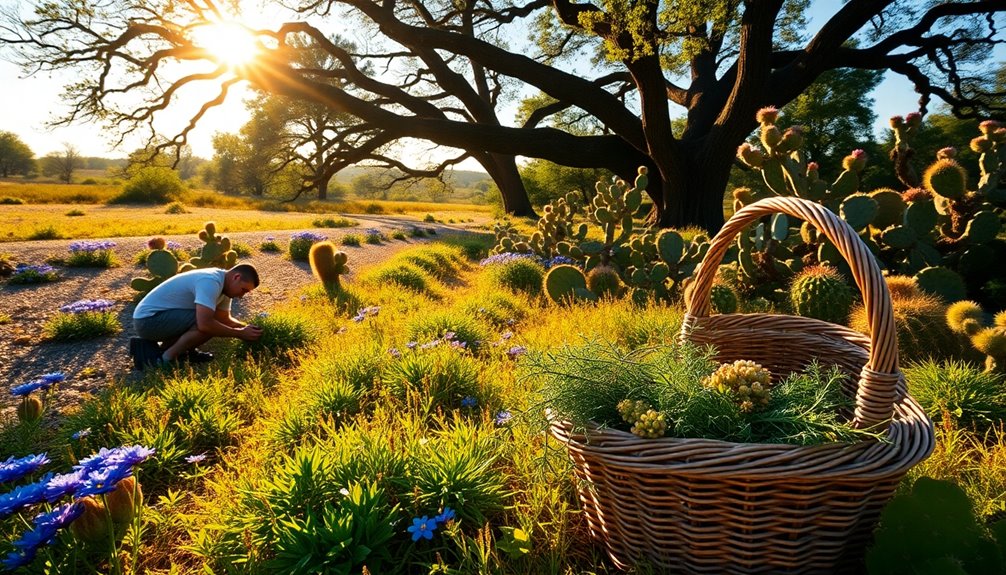
Foraging in Texas offers a unique way to connect with nature while discovering the state's diverse edible plants and fungi.
You'll find that foraging is legal in Texas, but it's crucial to navigate the various laws and regulations that apply. When harvesting wild food, remember that foraging on public lands, like Texas National Forests, comes with specific allowances: you can collect up to 1 gallon of mushrooms or 1 pint of fruits, nuts, or berries per person per day for personal use.
However, if you plan to forage on private property, you must get explicit permission from the landowner to avoid legal issues.
Additionally, be aware that local ordinances may impose extra restrictions, so take the time to familiarize yourself with your area's harvesting regulations.
Don't forget to respect endangered species and protected plants; harvesting these can lead to significant legal penalties ranging from $500 to $2100.
Legal Framework for Foraging

Understanding the legal framework for foraging in Texas is crucial for anyone looking to explore the state's rich natural bounty. Foraging on private property requires you to get permission from the landowners.
On public lands, however, the rules change. In Texas National Forests, you're allowed to collect up to 1 gallon of mushrooms per person per day for personal use. If you're in Big Thicket National Preserve, you can gather up to 1 pint of fruit, nuts, or berries daily.
Keep in mind that local ordinances can impose additional harvesting restrictions, and fines for illegal foraging can range from $500 to $2100.
It's also important to be aware of protected and endangered species. Foraging certain plants may be prohibited to help maintain biodiversity and protect ecosystem health.
Always check the specific regulations for the area you're exploring to guarantee you're in compliance. By understanding these laws, you can enjoy foraging while respecting Texas's natural resources.
Ethical Foraging Practices
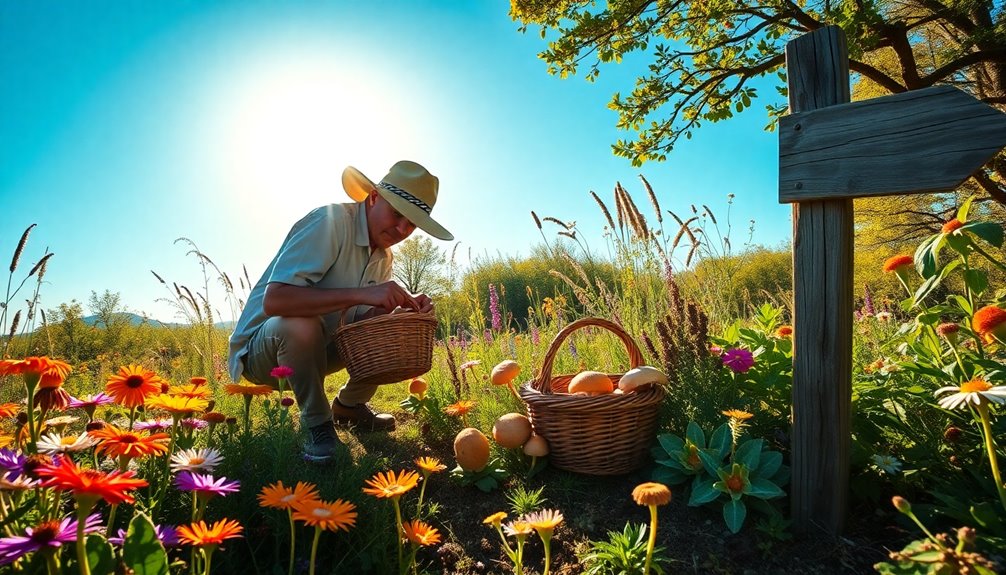
Ethical foraging practices focus on taking only what you need while making sure enough remains for wildlife and plant regeneration. Always obtain landowners' permission before foraging on private property; this respects property rights and local regulations.
When foraging, be mindful of contamination. Avoid areas polluted by pesticides or other harmful substances to make certain the wild foods you collect are safe to consume.
Additionally, recognizing the cultural significance of certain plants to Indigenous communities is crucial. This awareness fosters respect and appreciation for traditional uses and promotes conservation efforts in Texas.
Educating others about responsible foraging practices helps build a community dedicated to sustainable harvesting techniques. By sharing knowledge, you contribute to a culture of conservation that protects local ecosystems. Engaging in these practices can also enhance your understanding of natural materials and their benefits, much like the philosophy behind Waldorf toys.
Common Edible Plants

In Texas, you can find a wealth of common edible plants waiting to be foraged.
From popular wild greens to delicious nut varieties and sweet edible berries, each offers unique flavors and nutrients.
Knowing where to look can enhance your culinary adventures while enjoying the great outdoors.
Popular Wild Greens
Across the diverse landscapes of Texas, foragers can discover a variety of popular wild greens that offer both nutrition and flavor.
These edible plants aren't only legal to forage but also provide a bounty of health benefits. Here are some common wild greens you might encounter:
- Dandelion: Harvest the leaves for salads or teas; they're packed with vitamins A and K.
- Chickweed: This tender green adds a mild flavor to salads, soups, or serves as a garnish.
- Purslane: Often mistaken for a weed, it's rich in omega-3 fatty acids and can be enjoyed raw or cooked.
- Lamb's quarters: Known as wild spinach, it's versatile and highly nutritious, perfect for cooking or adding to salads.
Foraging for these wild greens in Texas can be a rewarding experience.
Not only do they enhance your meals, but they also connect you to the land.
Nut Varieties
Foragers in Texas can also enjoy a variety of nut species that add both flavor and nutrition to their meals. The pecan, Texas's state tree, is perhaps the most famous edible nut, known for its rich taste and versatility in dishes. You'll find them easy to harvest and crack, making them a favorite among foragers.
Another option is the black walnut. While it has a more intense flavor that many bakers love, be prepared for the challenge of cracking its tough shell.
If you're adventurous, consider acorns from oak trees. Once you leach their tannins, they become a nutritious ingredient that can be ground into flour or used in various recipes.
Don't overlook the Texas wild olive, either. Though less common, its edible seeds offer a unique taste worth trying.
Remember, proper identification is essential when foraging. Some nut varieties may produce toxic nuts or seeds, so brush up on your knowledge before you start harvesting. Additionally, incorporating foraged nuts into your diet can provide beneficial antioxidants that combat oxidative stress, enhancing your overall health.
With a little care and attention, you can safely enjoy the delicious bounty Texas has to offer!
Edible Berries
Wild berries frequently beckon to those exploring Texas's landscapes, offering a delicious and nutritious treat. When foraging for edible berries, it's essential to master identification, as some look-alikes, like the poisonous pokeweed berries, can be harmful.
Common varieties you might encounter include:
- Blackberries
- Blueberries
- Dewberries
- Elderberries
These berries are typically found in the wild from late spring to early summer. In Texas, you can harvest up to 1 pint of berries per person per day in designated public areas, such as the Big Thicket National Preserve. Many foragers appreciate the economic benefits of gathering wild foods, as it can supplement their diet and reduce grocery costs.
However, if you're eyeing a patch of berries on private land, remember to get explicit permission from the landowner first.
Beyond their delicious taste, these berries are packed with vitamins and antioxidants, making them a fantastic addition to your diet. Sustainable harvesting practices are crucial for ensuring that these berry populations thrive for future foragers.
So, gear up for a foraging adventure! Just make sure you're well-informed about the various species and their habitats. With a little knowledge and respect for the land, you can enjoy the bounty of Texas's wild fruits safely and legally.
Happy foraging!
Foraging Locations in Texas
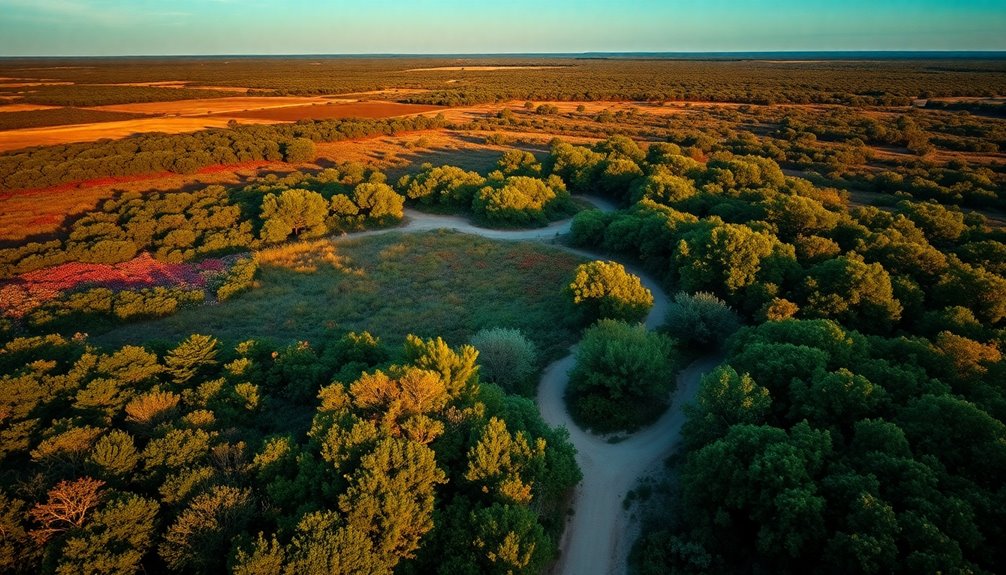
If you're enthusiastic to explore the diverse foraging opportunities in Texas, you'll find a wealth of locations to satisfy your curiosity. From public parks to rural landscapes, there's something for everyone.
Texas National Forests are particularly inviting, where you can collect up to 1 gallon of mushrooms per person per day for personal use. The Big Thicket National Preserve is another gem, allowing you to gather up to 1 pint of fruit, nuts, or berries daily.
In urban areas, don't overlook the abundance of fruit trees lining the streets or parks. These spots can yield delicious wild edible plants right in your neighborhood.
However, if you're considering foraging on private land, always remember to seek permission from the landowner first.
You might also want to check out local farmers' markets, where vendors often showcase foraged products and provide valuable insights into local edible plants.
With so many foraging locations across Texas, your adventure into wild foods is just beginning!
Health Benefits of Foraging

- Vitamins and Minerals: Edible plants like wild onions are high in essential vitamins, aiding digestive health and even providing relief from colds.
- Fiber Content: Native plants like nopal and prickly pear fruit offer high fiber content, which can help regulate cholesterol levels.
- Antioxidants: Many foraged foods, such as pecans and dewberries, are rich in antioxidants, contributing to heart health and reducing inflammation.
- Physical Activity and Mental Health: Foraging encourages outdoor engagement, promoting physical activity that can improve your fitness and mental health.
- Gastrointestinal Benefits: Incorporating wild foods into your diet can also support digestive health, helping to maintain a balanced gut microbiome.
Incorporating these wild foods into your meals gives you a diverse range of nutrients while connecting you with nature.
Culinary Uses of Wild Foods
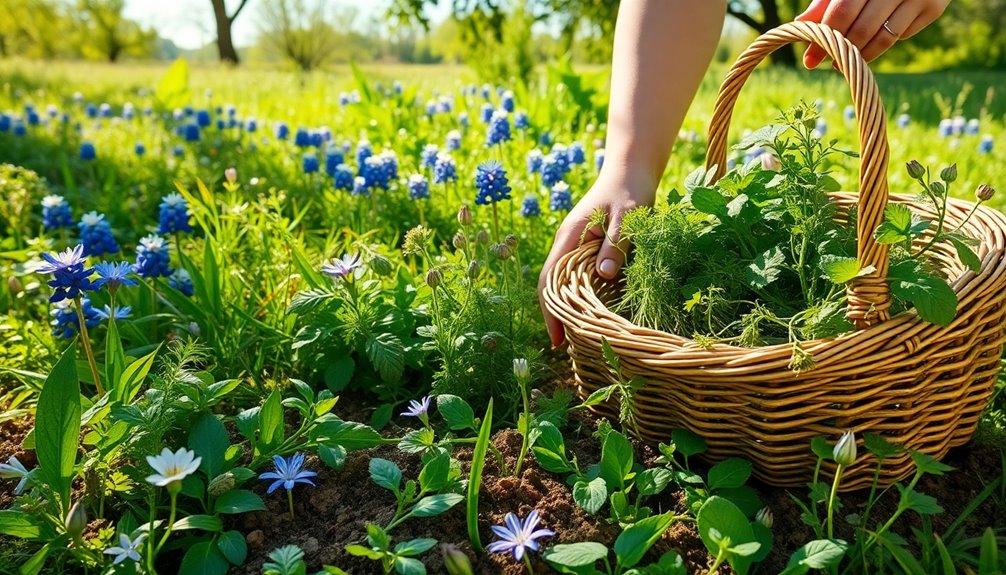
Throughout the year, Texas offers a bounty of foraged ingredients that can elevate your culinary creations. Wild foods like prickly pear and dewberry aren't just delicious; they also enhance the nutritional value of your meals. You can creatively incorporate these foraged ingredients into culinary dishes, such as making dewberry preserves or prickly pear syrup, showcasing the versatility of native edibles. Additionally, the incorporation of essential oils into your cooking can further amplify both flavor and health benefits.
Consider using edible plants like wild onions and nopal (cactus) in your salads or light stir-fries. These ingredients aren't only rich in fiber and antioxidants but also promote sustainable harvesting practices. Additionally, foraged ingredients can be paired with fermented vegetable plates to create a dish that is not only flavorful but also beneficial for gut health. Understanding the importance of diversification in your diet can help you appreciate the variety of flavors and nutrients that wild foods provide. This knowledge of local wild foods can foster a sense of community connection to the environment and enhance your appreciation for nature's offerings.
Knowing how to prepare these wild foods connects you to local ecosystems and cultural traditions that have been celebrated for generations. Moreover, many foraged ingredients can contribute to cognitive development by providing unique flavors and textures that stimulate sensory processing.
Community Resources and Classes
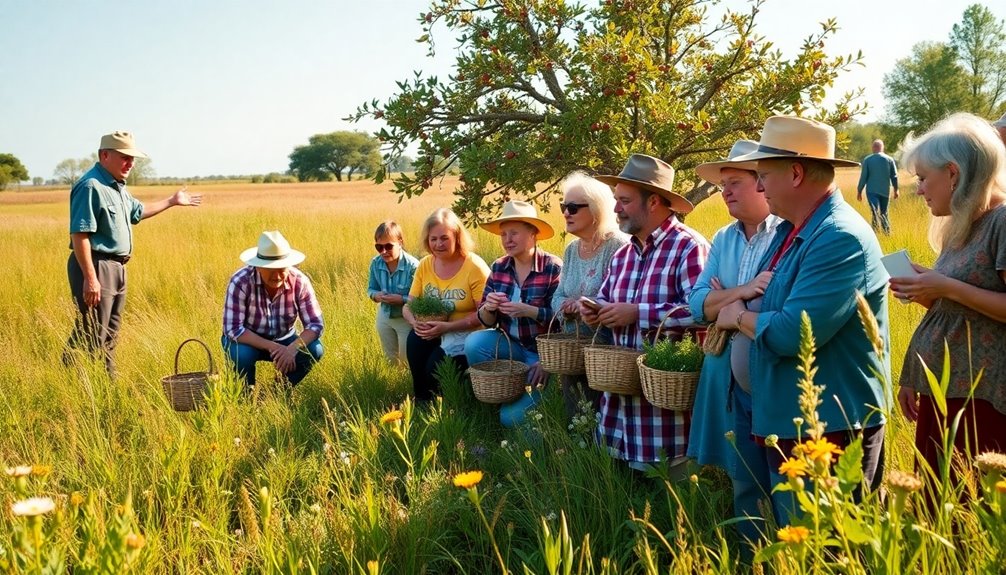
Community resources and classes across Texas make foraging accessible and enjoyable for everyone. Numerous community organizations and local foraging groups offer workshops that provide hands-on experience in plant identification and sustainable foraging practices.
You can easily find classes that cover essential topics like ethical harvesting and the nutritional value of wild foods.
Here are some great ways to get involved:
- Join local foraging groups: These communities share tips and arrange foraging outings.
- Attend educational programs: Farmer's markets often host demonstrations on native edible plants and their benefits.
- Sign up for foraging classes: Many libraries and community centers offer classes on food preparation from wild foods.
- Connect with conservation organizations: Participate in events focused on preserving native plants and learning sustainable foraging techniques.
Safety and First Aid Tips
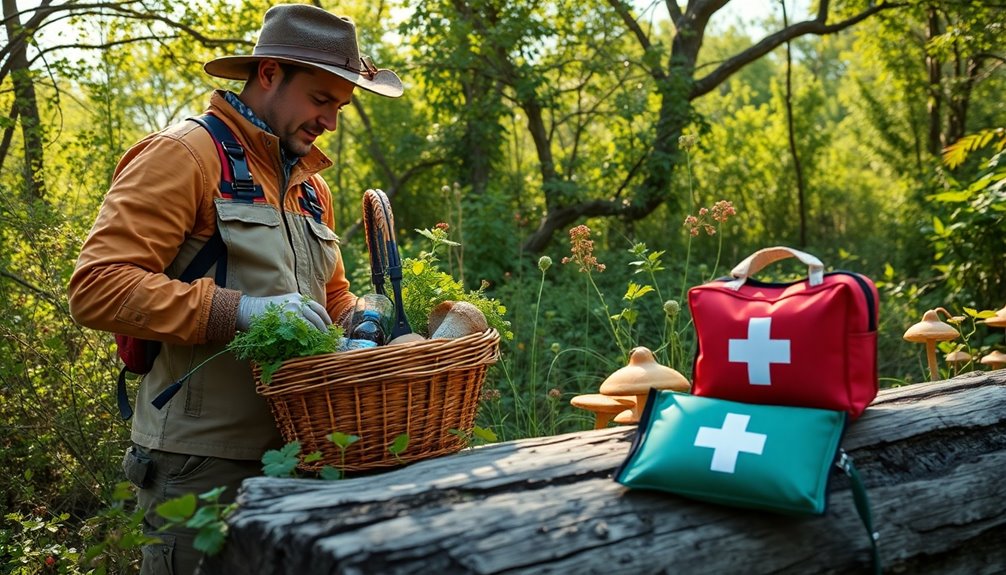
When you head out foraging, always have a basic first aid kit on hand to handle any minor injuries.
It's also smart to keep contact information for local poison control centers accessible, just in case you accidentally ingest something toxic.
First Aid Essentials
Foragers need to be prepared for any minor injuries or unexpected situations that can arise while exploring the great outdoors. Having basic first aid knowledge is vital. You'll likely encounter cuts, scrapes, and insect bites during your foraging activities, so knowing how to treat them can make all the difference. A well-maintained first aid kit can significantly enhance your safety while foraging, similar to how adequate maintenance can prevent heat pump failures.
Make sure to pack a basic first aid kit that includes:
- Antiseptics for cleaning wounds
- Bandages to cover cuts and scrapes
- Personal medications for allergies or conditions
- A list of local poison control centers for quick access in case of accidental ingestion of toxic plants or mushrooms. It's important to be aware of toxic plants that may be present in your foraging area. Additionally, understanding the potential health impacts of wood smoke exposure can help you make safer choices while foraging in wooded areas. In particular, knowing how to properly remove ticks from pets can be beneficial if you encounter them during your outdoor adventures.
Additionally, understanding survival skills like shelter building and fire starting can be invaluable if you're in a remote area and need to improvise. Sustainable harvesting techniques can also help ensure that you forage responsibly while protecting the ecosystem.
Finally, knowing food preservation methods is essential for safely storing the foraged foods you collect, helping to prevent spoilage and foodborne illnesses. Always be ready for anything, and you'll enjoy your foraging adventures to the fullest!
Emergency Contact Resources
Having the right emergency contact resources is crucial for a safe foraging experience. Before you head out, keep a list of local poison control centers handy, like the Texas Poison Center Network, which can provide immediate assistance if you accidentally ingest something harmful while foraging. Additionally, be aware that some wild foods can resemble candy varieties that are toxic, so proper identification is essential. It's important to remember that emotional neglect can occur if you are unprepared for the risks associated with foraging, so always prioritize safety. Moreover, understanding that certain foods carry hidden dangers can help you make informed choices. Regular use of air purifiers can improve indoor air quality, which is beneficial for overall health during your foraging preparation.
Familiarize yourself with basic first aid skills, especially how to treat allergic reactions, cuts, and insect bites that might occur during your wild foods adventures. Always carry a well-stocked first aid kit, including antiseptic wipes, band-aids, and allergy medication, to address potential injuries or allergic reactions.
In case of severe reactions, know the nearest hospital or urgent care facility and how to reach them quickly. These steps are crucial for foraging safety. Understanding the importance of empathy in emergencies can also ensure that you are prepared to help others if needed.
Additionally, consider utilizing resources like the American Red Cross for emergency preparedness training. This knowledge can enhance your overall safety while enjoying foraging. Regular outings to safe areas can also help improve your confidence in foraging, similar to how puppy socialization aids in developing adaptable dogs.
By having these emergency contact resources in place, you can enjoy your foraging trips with greater peace of mind, knowing you're prepared to handle any unexpected situations that may arise.
Stay safe and informed!
Frequently Asked Questions
Can You Forage in Texas State Parks?
You can't forage in Texas state parks without explicit permission from park authorities.
The regulations are strict to protect local ecosystems and wildlife habitats. If you're caught collecting plants or mushrooms, you could face fines ranging from $500 to $2100, depending on the offense.
Some parks offer educational programs to learn about the local flora, so it's a good idea to check specific rules before your visit. Always stay informed!
Where Is Foraging Illegal?
Imagine wandering through a lush, green forest, only to realize foraging's forbidden in many places.
In national parks and protected areas, you can't harvest wild plants—it's all about preserving nature. Public parks may have local rules, while private land means you need the owner's blessing.
Be cautious, as some regions protect endangered species too. Ignoring these laws could cost you big, with fines reaching up to $2,100.
Always check local regulations before you start!
What Are the Rules for Foraging?
When you're foraging, you need to follow specific rules. Always get permission if you're on private land.
On public land, check local ordinances, as they can vary. In Texas National Forests, you can collect up to 1 gallon of mushrooms daily, while in Big Thicket, you're limited to 1 pint of fruits, nuts, or berries.
Be mindful of endangered species, as collecting them can be illegal and harmful to the environment.
What Are Three Cautions Regarding Foraging?
When you're foraging, have you considered the potential risks?
First, always get explicit permission before entering private land—trespassing can lead to legal trouble.
Second, accurately identify edible plants; many have toxic look-alikes that can cause serious harm.
Finally, be aware of local laws and protected species; harvesting them can result in hefty fines and negatively impact biodiversity.
Staying informed will help you forage safely and responsibly.
Conclusion
In Texas, foraging not only connects you to nature but also offers incredible health benefits. Did you know that about 80% of the world's population relies on wild foods for their nutrition? By exploring the Lone Star State's diverse landscape, you can discover a variety of edible plants while also respecting the environment. So grab your basket, and start your foraging adventure—there's a world of flavors waiting just outside your door!



